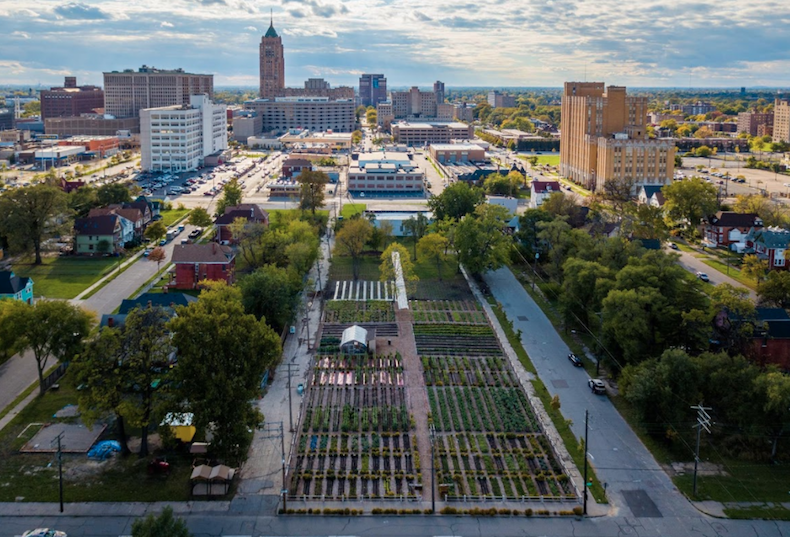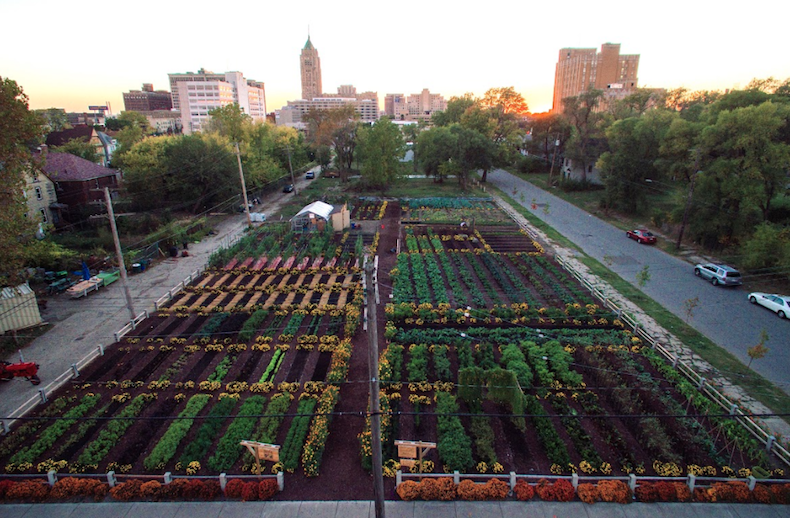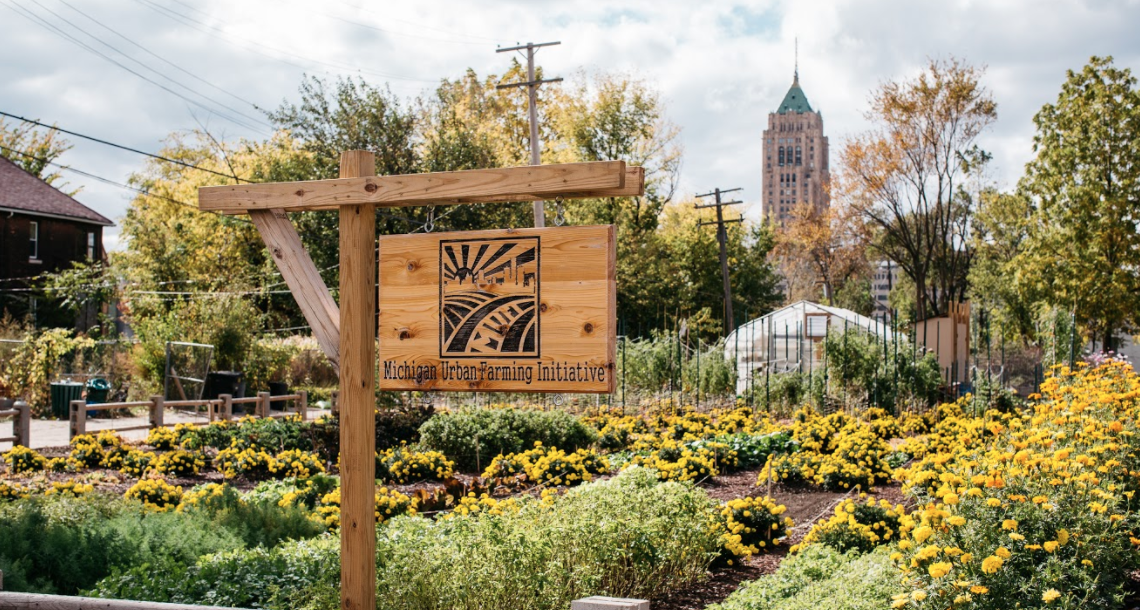Urban farms have been impacting cities’ agribusiness—and, on some cases, their redevelopment—for decades.
In Philadelphia, for example, the success of Greensgrow Farms—whose 6,000-sf flagship greenhouse celebrated its 20th anniversary in 2017, and whose three locations (which include a retail garden center and farmstand) draw 15,000 people per year—has spurred numerous competitors, and has helped gentrify its surrounding working-class neighborhoods.
Since 2011, Gotham Greens has operated a 15,000-sf enclosed rooftop greenhouse in the Greenpoint section of Brooklyn, N.Y., that produces over 100,000 lbs of leafy greens annually. The greenhouse is a tenant of the Greenpoint Manufacturing Design Center, a nonprofit developer dedicated to revitalizing Brooklyn’s industrial spaces for small-scale entrepreneurial manufacturing.
Gotham Greens also operates a 20,000-sf greenhouse in the Gowanus section of Brooklyn that grows over 200,000 lbs of greens, herbs, and tomatoes; a five-story, 60,000-sf greenhouse in the Hollis section of Queens, N.Y., that employs 50 full time workers and produces over 5 million heads of leafy greens; and a 75,000-sf greenhouse on two acres of Chicago’s south side that opened in 2015 and now produces 10 million heads of greens and herbs annually.
 MUFI is developing what it’s calling America’s first “Agrihood,” which will include the adaptive reuse of several buildings on its three-acre complex. A now-vacant, three-story apartment building that dates back to 1915 (pictured) is being converted into a 3,200-sf Community Resource Center. Catalyst Partners is supervising these rehab projects for MUFI, and Integrity Building Group is the AOE and CM. Other Building Team members include Ingalls Engineering Group (M/PE and net-zero energy consultant), IlluminArt Lighting, a division of Peter Basso (EE), Insite Design Studio (design and CE), Jeremy Ziegler (architect). Photo: Michelle and Chris Gerard
MUFI is developing what it’s calling America’s first “Agrihood,” which will include the adaptive reuse of several buildings on its three-acre complex. A now-vacant, three-story apartment building that dates back to 1915 (pictured) is being converted into a 3,200-sf Community Resource Center. Catalyst Partners is supervising these rehab projects for MUFI, and Integrity Building Group is the AOE and CM. Other Building Team members include Ingalls Engineering Group (M/PE and net-zero energy consultant), IlluminArt Lighting, a division of Peter Basso (EE), Insite Design Studio (design and CE), Jeremy Ziegler (architect). Photo: Michelle and Chris Gerard
Several urban farms operate in Detroit, including the six-year-old Michigan Urban Farm Initiative (MUFI), which grows 300 varieties of vegetables on two acres in the Motor City’s North End. Since 2012, MUFI has produced more than 50,000 lbs of produce, which it distributes free to 2,000 households within two square miles of the farm.
In November, during the Greenbuild Expo, MUFI announced its plans to develop what it’s calling the first sustainable “Agrihood” in the U.S., as an alternative neighborhood growth model.
Working with such high-profile partners and sponsors as BASF, Herman Miller, and General Motors, MUFI is converting a vacant 102-year-old three-story apartment building across from its urban garden into a 3,200-sf Community Resource Center. The Center will include two commercial kitchens on the first floor and allow for future production and packaging of valued goods.
On land next to the CRC, MUFI intends to open a healthy food café. It also plans to convert an existing single-family home on the farm’s premises to housing for the farm’s interns. The foundation of another single-family home has been fortified to support a two-bedroom home made from a shipping container. And the basement of a recently fire-damaged and deconstructed home on the farm’s border is being converted into a 12,000-gallon rainwater harvesting cistern that will be used to irrigate the farm and prevent runoff into Detroit’s sewer system.
Integrity Building Group is AOR and provides architecture services and construction for the farm. One of MUFI’s partners, Sustainable Brands, will debut the CRC and café at its conference in Detroit’s Cobo Arena next May.
“Cities are the future, but we can’t just rebuild the same inefficient buildings of the past,” says John Beeson, LEED AP BD+C, EBO+M, a project manager with Catalyst Partners in Grand Rapids, Mich., which is supervising these reconstructions for MUFI. “The question we’re trying to answer is whether we can do urban infill better.”
Tyson Gersh, MUFI’s cofounder, says that while urban redevelopment “was not on our radar screen at first,” it has become a priority, partly for political reasons, but also because “it’s hard for an urban farm to justify itself on its own.”
Gersh observed “quite a few people” who were buying blighted homes around the farm. (He’s identified at least $3.5 million in purchases so far.) Several of those new owners told Gerson they wouldn’t have heard of this neighborhood were it not for the farm.
MUFI is now working with several developers—including The Platform, Basco, Terranova Development, and South Oakland Shelter—on another residential project that would be two blocks from the farm.
 Photo: Michelle and Chris Gerard
Photo: Michelle and Chris Gerard
Related Stories
AEC Tech | Feb 20, 2024
AI for construction: What kind of tool can artificial intelligence become for AEC teams?
Avoiding the hype and gathering good data are half the battle toward making artificial intelligence tools useful for performing design, operational, and jobsite tasks.
AEC Innovators | Jun 15, 2023
Rogers-O'Brien Construction pilots wearables to reduce heat-related injuries on jobsites
Rogers-O'Brien Construction (RO) has launched a pilot program utilizing SafeGuard, a safety-as-a-service platform for real-time health and safety risk assessment. Non-invasive wearables connected to SafeGuard continuously monitor personnel to prevent heat exhaustion on jobsites, reducing the risk of related injuries. RO is the first general contractor to pilot this program.
Office Buildings | May 15, 2023
Sixteen-story office tower will use 40% less energy than an average NYC office building
This month marks the completion of a new 16-story office tower that is being promoted as New York City’s most sustainable office structure. That boast is backed by an innovative HVAC system that features geothermal wells, dedicated outdoor air system (DOAS) units, radiant heating and cooling, and a sophisticated control system to ensure that the elements work optimally together.
K-12 Schools | May 12, 2023
In Virginia, a new high school building helps reimagine the experience for 1,600 students
In Virginia, the City of Alexandria recently celebrated the topping out of a new building for Alexandria City High School. When complete in 2025, the high-performance structure will accommodate 1,600 students.
Hotel Facilities | May 9, 2023
A new camping destination near Utah’s Zion National Park offers a variety of all-season lodgings and amenities
Outdoor lodging brand AutoCamp has opened a new camping destination near Utah’s Zion National Park. A 16-acre property, AutoCamp Zion is located between the Virgin River and the desert of Southern Utah.
Concrete Technology | Apr 24, 2023
A housing complex outside Paris is touted as the world’s first fully recycled concrete building
Outside Paris, Holcim, a Swiss-based provider of innovative and sustainable building solutions, and Seqens, a social housing provider in France, are partnering to build Recygénie—a 220-unit housing complex, including 70 social housing units. Holcim is calling the project the world’s first fully recycled concrete building.
Design Innovation Report | Apr 19, 2023
Reinforced concrete walls and fins stiffen and shade the National Bank of Kuwait skyscraper
When the National Bank of Kuwait first conceived its new headquarters more than a decade ago, it wanted to make a statement about passive design with a soaring tower that could withstand the extreme heat of Kuwait City, the country’s desert capital.
Design Innovation Report | Apr 19, 2023
HDR uses artificial intelligence tools to help design a vital health clinic in India
Architects from HDR worked pro bono with iKure, a technology-centric healthcare provider, to build a healthcare clinic in rural India.
Urban Planning | Apr 12, 2023
Watch: Trends in urban design for 2023, with James Corner Field Operations
Isabel Castilla, a Principal Designer with the landscape architecture firm James Corner Field Operations, discusses recent changes in clients' priorities about urban design, with a focus on her firm's recent projects.
3D Printing | Apr 11, 2023
University of Michigan’s DART Laboratory unveils Shell Wall—a concrete wall that’s lightweight and freeform 3D printed
The University of Michigan’s DART Laboratory has unveiled a new product called Shell Wall—which the organization describes as the first lightweight, freeform 3D printed and structurally reinforced concrete wall. The innovative product leverages DART Laboratory’s research and development on the use of 3D-printing technology to build structures that require less concrete.

















